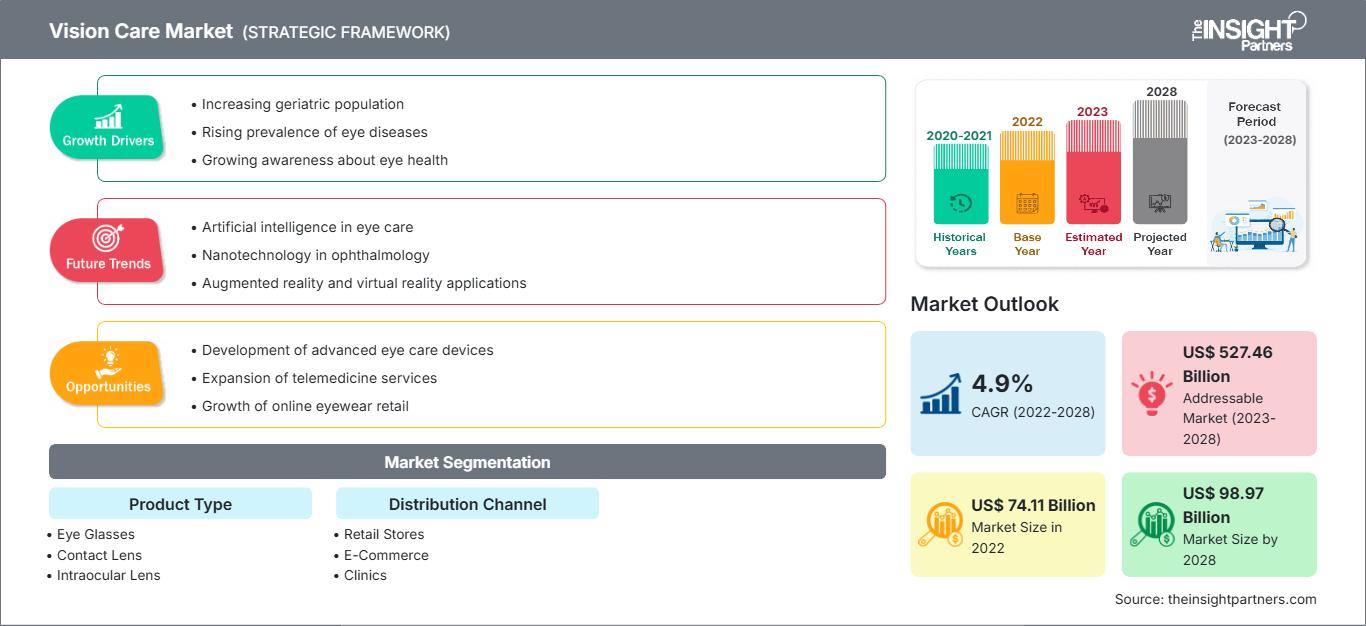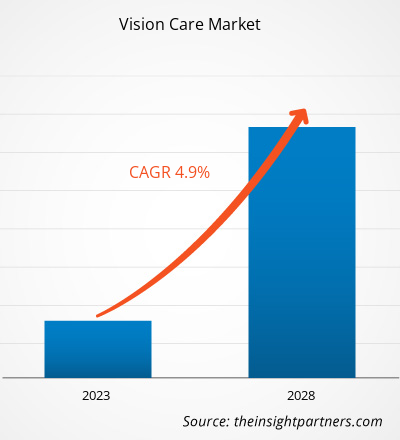Se prevé que el mercado de la atención oftalmológica crezca de 74.110,14 millones de dólares estadounidenses en 2022 a 98.968,42 millones de dólares estadounidenses en 2028; se estima que registrará una tasa de crecimiento anual compuesta (TCAC) del 4,9% entre 2022 y 2028.
Los productos para el cuidado de la visión incluyen anteojos, lentes de contacto, lentes intraoculares, soluciones para lentes de contacto, gotas oftálmicas y otros. La creciente prevalencia de trastornos oculares impulsa el desarrollo de productos avanzados para el cuidado de la visión. Asimismo, el aumento de programas de concientización sobre el cuidado de la visión fomenta la adopción de estos productos en todo el mundo.
Perspectivas del mercado
El aumento de la prevalencia de enfermedades oculares impulsa el crecimiento del mercado de la atención oftalmológica
Una amplia variedad de enfermedades oculares, como cataratas, glaucoma y errores de refracción, son frecuentes en todo el mundo. Según un artículo publicado por la Organización Mundial de la Salud (OMS) en 2022, aproximadamente 2200 millones de personas en el mundo padecen discapacidad visual cercana o lejana. Las principales causas de discapacidad visual son las cataratas (aproximadamente 94 millones de casos) y los errores de refracción no corregidos (aproximadamente 88,4 millones de casos). Otras causas de discapacidad visual son el glaucoma, las opacidades corneales, la retinopatía diabética y el tracoma, con aproximadamente 7,7 millones, 4,2 millones, 3,9 millones y 2 millones de casos, respectivamente. Según datos de los Centros para el Control y la Prevención de Enfermedades (CDC), aproximadamente 12 millones de personas en Estados Unidos, mayores de 40 años, padecían discapacidad visual en 2022; de ellas, 3 millones presentaban discapacidad visual tras la corrección y 8 millones la padecían debido a un índice de refracción no corregido. El aumento de la incidencia de diabetes y otras enfermedades crónicas es responsable de la alta prevalencia de discapacidad visual en la población estadounidense. Según los resultados de la Encuesta Canadiense de Medidas de Salud realizada entre 2016 y 2019, el 50,4 % de los adultos de 40 a 64 años y el 71,6 % de los adultos mayores de 65 a 79 años indicaron haber consultado a un oftalmólogo el año anterior. Además, según el Real Instituto Nacional de Personas Ciegas, en 2021, en el Reino Unido, aproximadamente 2 millones de personas vivían con discapacidad visual. En 2021, se registraron alrededor de 340 000 personas ciegas o con discapacidad visual en el Reino Unido. Según datos del Gobierno de la India, se realizaron aproximadamente 5,7 millones de cirugías de cataratas entre 2021 y 2022, mientras que entre 2020 y 2021 se llevaron a cabo aproximadamente 3,6 millones.
Además, el envejecimiento de la población y la fuerza laboral en distintos países, junto con las crecientes exigencias visuales de las ocupaciones modernas, ponen de manifiesto el impacto de la baja visión y la ceguera en las economías. Por consiguiente, la alta prevalencia de la discapacidad visual y la ceguera en diversas partes del mundo impulsa el crecimiento del mercado de la atención oftalmológica.
Obtendrá personalización gratuita de cualquier informe, incluyendo partes de este informe, análisis a nivel de país y paquetes de datos de Excel. Además, podrá aprovechar excelentes ofertas y descuentos para empresas emergentes y universidades.
Mercado del cuidado de la visión: Perspectivas estratégicas

-
Obtenga las principales tendencias clave del mercado que se describen en este informe.Esta muestra GRATUITA incluirá análisis de datos, que abarcarán desde tendencias de mercado hasta estimaciones y pronósticos.
El creciente interés por el cuidado de la visión ofrece amplias oportunidades para el mercado.
En los últimos años, se han implementado diversas medidas para concientizar y educar a la población sobre las enfermedades oculares, facilitando así el acceso de los pacientes a los medicamentos y tratamientos adecuados. En 2017, el Instituto Nacional del Ojo (NEI, por sus siglas en inglés) de Estados Unidos lanzó «Write the Vision», un nuevo programa de concientización sobre la salud ocular dirigido específicamente a la comunidad afroamericana. «Write the Vision» ofrece recursos mensuales a numerosas organizaciones, permitiéndoles promover la salud visual y prevenir la pérdida de visión y la ceguera en las comunidades a las que sirven. Según el Programa Nacional de Educación sobre la Salud Ocular, perteneciente al NEI, la población afroamericana es más propensa a padecer enfermedades oculares, las cuales, si no se tratan a tiempo, pueden provocar la pérdida de visión. Por ello, se creó el programa «Write the Vision» para fomentar la concientización sobre la salud ocular.
Sightsavers, una organización no gubernamental internacional, trabaja en países en desarrollo para tratar y prevenir enfermedades oculares. Una gran parte de la población de la India reside en zonas rurales, con escaso o nulo conocimiento sobre las afecciones oculares. Sightsavers busca crear conciencia a través de su Programa de Salud Ocular Rural, brindar servicios de salud ocular de alta calidad y erradicar la ceguera evitable en la población rural. Además, la OMS lanzó el evento «Cobertura Sanitaria Universal y Atención Oftalmológica: Promoción de la Acción Nacional», cuyo objetivo es proporcionar orientación práctica y paso a paso para apoyar a los Estados Miembros de la OMS en la planificación e implementación de las recomendaciones del Informe Mundial sobre la Visión de la OMS. La OMS lanzó este evento con el fin de proporcionar servicios integrales de atención oftalmológica centrados en las personas. Por lo tanto, el creciente número de programas de concientización sobre la salud ocular está generando oportunidades de crecimiento para el mercado de la atención oftalmológica.
Información basada en el tipo de producto
Según el tipo de producto, el mercado de la salud visual se segmenta en gafas, lentes de contacto, lentes intraoculares y otros. El segmento de gafas ostentó la mayor cuota de mercado en 2021 y se prevé que experimente el mayor crecimiento anual compuesto durante el período de pronóstico.
Información basada en el canal de distribución
Según el canal de distribución, el mercado de la atención oftalmológica se segmenta en tiendas minoristas, comercio electrónico, clínicas y hospitales. El segmento de tiendas minoristas representó la mayor cuota de mercado en 2021, y se prevé que el segmento de comercio electrónico registre la mayor tasa de crecimiento anual compuesto (TCAC) del 9,5 % durante el período de pronóstico.
Perspectivas regionales del mercado de la atención oftalmológica
Los analistas de The Insight Partners han explicado en detalle las tendencias y los factores regionales que influyen en el mercado de la salud visual durante el período de previsión. Esta sección también analiza los segmentos y la geografía del mercado de la salud visual en Norteamérica, Europa, Asia Pacífico, Oriente Medio y África, y Sudamérica y Centroamérica.
Alcance del informe de mercado de atención oftalmológica
| Atributo del informe | Detalles |
|---|---|
| Tamaño del mercado en 2022 | 74.110 millones de dólares estadounidenses |
| Tamaño del mercado para 2028 | US$ 98.97 mil millones |
| Tasa de crecimiento anual compuesto global (2022 - 2028) | 4,9% |
| Datos históricos | 2020-2021 |
| período de previsión | 2023-2028 |
| Segmentos cubiertos |
Por tipo de producto
|
| Regiones y países cubiertos |
América del norte
|
| Líderes del mercado y perfiles de empresas clave |
|
Densidad de los actores del mercado de la atención oftalmológica: comprensión de su impacto en la dinámica empresarial
El mercado del cuidado de la visión está creciendo rápidamente, impulsado por la creciente demanda de los usuarios finales debido a factores como la evolución de las preferencias de los consumidores, los avances tecnológicos y una mayor conciencia de los beneficios del producto. A medida que aumenta la demanda, las empresas amplían su oferta, innovan para satisfacer las necesidades de los consumidores y aprovechan las nuevas tendencias, lo que impulsa aún más el crecimiento del mercado.

- Obtenga una visión general de los principales actores del mercado del cuidado de la visión.
Las empresas del sector de la salud visual adoptan estrategias de crecimiento orgánico e inorgánico, como fusiones y adquisiciones. A continuación, se enumeran algunos de los principales avances recientes del mercado:
- En marzo de 2022, Alcon Inc. lanzó la familia de lentes intraoculares Clareon en EE. UU. Gracias al material más avanzado de Alcon para lentes intraoculares, Clareon ofrece resultados visuales consistentes y una claridad excepcional y duradera.
- En enero de 2022, Alcon lanzó DAILIES TOTAL1 para el astigmatismo, la primera y única lente de contacto Water Gradient para pacientes con astigmatismo.
- En junio de 2022, CooperVision adquirió EnsEyes, proveedor líder de lentes de contacto de ortoqueratología (orto-k) y esclerales en la región nórdica. La empresa operará dentro del grupo CooperVision Specialty EyeCare.
- En febrero de 2021, Johnson & Johnson Vision Inc. obtuvo la marca CE para su lente de contacto multifocal Acuvue Oasys, con diseño optimizado para la pupila, destinada al tratamiento de la presbicia en Europa.
Perfiles de empresas
- Alcon Inc
- Bausch Health Companies Inc
- Carl Zeiss AG
- Cooper Companies Inc
- Essilorluxottica SA
- Servicios Johnson & Johnson Inc.
- Corporación Hoya
- Rodenstock GmbH
- Menicon Co. Ltd
- Rayner Lentes Intraoculares Limitada
- Análisis histórico (2 años), año base, pronóstico (7 años) con CAGR
- Análisis PEST y FODA
- Tamaño del mercado, valor/volumen: global, regional y nacional
- Industria y panorama competitivo
- Conjunto de datos de Excel
Informes recientes
Testimonios
Razón para comprar
- Toma de decisiones informada
- Comprensión de la dinámica del mercado
- Análisis competitivo
- Información sobre clientes
- Pronósticos del mercado
- Mitigación de riesgos
- Planificación estratégica
- Justificación de la inversión
- Identificación de mercados emergentes
- Mejora de las estrategias de marketing
- Impulso de la eficiencia operativa
- Alineación con las tendencias regulatorias






















 Obtenga una muestra gratuita para - Mercado del cuidado de la vista
Obtenga una muestra gratuita para - Mercado del cuidado de la vista